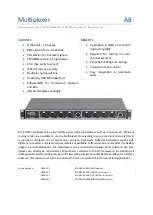
26
4. Taking Measurements
4.1 AC and DC Voltage Measurement
1. First turn the measuring tip (1) out of the unit by turning the moving
spindle (2) counter clockwise.
2. Connect the black measure probe with measuring tip or with the
crocodile clip to the COM-Input (13).
3. Turn the rotary function switch (5) to AC/DC measuring (V ). The
display (12) shows the scale unit “V“. For the intended voltage,
press the button “F-Func.“ (7) and the selected voltage “AC“ or
“DC“ appears in the display.
4. Now connect the measuring tip to the circuitry or the component
you intend to measure. When you measure DC voltage, observe
correct polarity. In that case the measuring tip of the meter is the
plus pole and the black measuring probe the minus pole.
5. Now you see the result in the LC-display (12). If a negative result is
measured, a minus symbol is displayed. Change the polarity, if
necessary, by changing the measuring probes.
6. To change the measuring range mode, press “R-Range” (8). The
scale “AUTO“ disappears and the measuring range can be set
manually. Press several times to change the measuring mode and
the scale units “mV“ or “V“ appear. If you want to go back to auto
range, press and hold the button “R-Range“ for approx. 2 seconds.
The display shows on the upper left the symbol “Auto“ for auto
range mode.
Hints:
If the unit shows after connecting to a measuring subject the
overflow value “O.L“, disconnect immediately the meter from the
measuring subject. In that case the measured voltage is too high.
While the unit is idle with the probes plugged in (without connecting
a measuring subject), the value in the display may change. This is
due to the high sensitivity that is shown in the LC-display (12). After
measuring, the value in the display corresponds to the accuracy
stated in the technical data.
The meter has an input resistance of 10 M
Ω
in all voltage measur-
ing ranges.













































